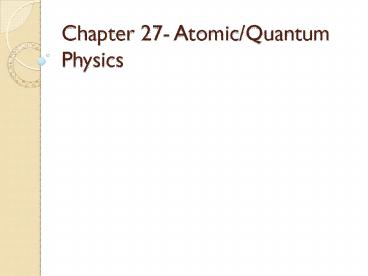Chapter 27- Atomic/Quantum Physics - PowerPoint PPT Presentation
Title:
Chapter 27- Atomic/Quantum Physics
Description:
Chapter 27- Atomic/Quantum Physics The Sun http://soho.nascom.nasa.gov/ Why do we see the sun as yellow instead of green or blue or pink? Blackbody Spectrum Photon ... – PowerPoint PPT presentation
Number of Views:91
Avg rating:3.0/5.0
Title: Chapter 27- Atomic/Quantum Physics
1
Chapter 27- Atomic/Quantum Physics
2
The Sun
- http//soho.nascom.nasa.gov/
- Why do we see the sun as yellow instead of green
or blue or pink?
3
Blackbody Spectrum
4
Photon Theory of Light
- Light is transmitted as tiny particles called
photons - The amount of energy in a photon depends on its
frequency
h Plancks Constant 6.626 x 10-34 Js f
frequency of light c speed of light ?
wavelength p momentum
5
The Photoelectric Effect
- When light shines on a metal surface, electrons
are emitted from the surface
6
Photocells (p.829)
- When the photocell is in the dark, the ammeter
reads 0 (no current) - When light with a high enough frequency shines on
the current flows in the circuit
7
Photocells
- KEmax of the emitted electrons can be found by
reversing the voltage and making the C electrode
negative - The electrons are repelled by C, but the fastest
electrons will still make it across - There is a minimum voltage, Vo, called the
stopping voltage. No current will flow if the
voltage is less than the stopping voltage - Kemax e Vo
8
Photoelectric Effect
- Einsteins Theory Predicts
- Increasing the intensity of the light does not
make the electrons go faster. - This is because although more photons are
striking the surface, they have same energy - Increasing the frequency of the light beam
increases the energy of the photons which changes
the maximum KE of the ejected electrons
9
Photoelectric Effect
- The work function, Wo, is the minimum amount of
energy necessary to get an electron off the
surface of the metal - fo is the cutoff frequency. If the light beams
frequency is below that, then no electrons will
be emitted
10
Compton Effect
- A.H. Compton scattered xrays from various
materials - Found out that the scattered light had a lower
frequency than incident light - Since frequency decreases, wavelength increases
- Used conservation of momentum to determine that
the photon transfers some of its energy to the
electron
11
de Broglie Wavelength
- Light sometimes behaves like a wave and sometimes
like a particle - Louis de Broglie came up with the idea that
particles might also have wave properties
De Broglie wavelength of a particle
12
de Broglie Wavelength
- The wavelength of large objects is very small
- For a 0.20 kg ball travelling at 15 m/s
13
de Broglie Wavelength
- Determine the wavelength of an electron that has
been accelerated through a potential difference
of 100 V
14
Davisson-Germer Experiment
- The spacing of atoms in a crystals is on the
order of 10-10 m, so one could be used as a
diffraction grating - In 1927, Davisson and Germer scattered electrons
from the surface of a metal crystal. The
wavelength they got matched the predicted de
Broglie wavelength
15
Bohr Model of the Atom
- Electrons orbit the nucleus in circular orbits
called stationary states - When an electron jumps from one state to another,
light is either absorbed or emitted - The energy required to go between states is a
fixed amount
16
Bohr Model of the atom
- If an electron jumps from a higher state to a
lower state, it emits a single photon of light
17
Energy Level Diagram (p. 847)
- n 1is ground state, n2,3,4.. Are excited states
- To completely free an electron in the ground
state, youd need to put in 13.6 eV of energy
(ionization energy of Hydrogen)
18
Energy Level Diagram
- How much energy to go from ground to n2?
- How much energy to go from n2 to n4?
19
Energy Level Diagrams
- What are the possible transitions for an electron
in excited state n3? - 3?1
- 3?2
- 2?1
20
Emission Spectra
- A materials emission spectrum show the
wavelengths of the photons emitted when electrons
jump to lower energy states
21
Absorption Spectra
- The absorption spectrum of a material shows that
gases can absorb light at the same frequencies at
which they emit
22
Absorption/Emission Spectra































